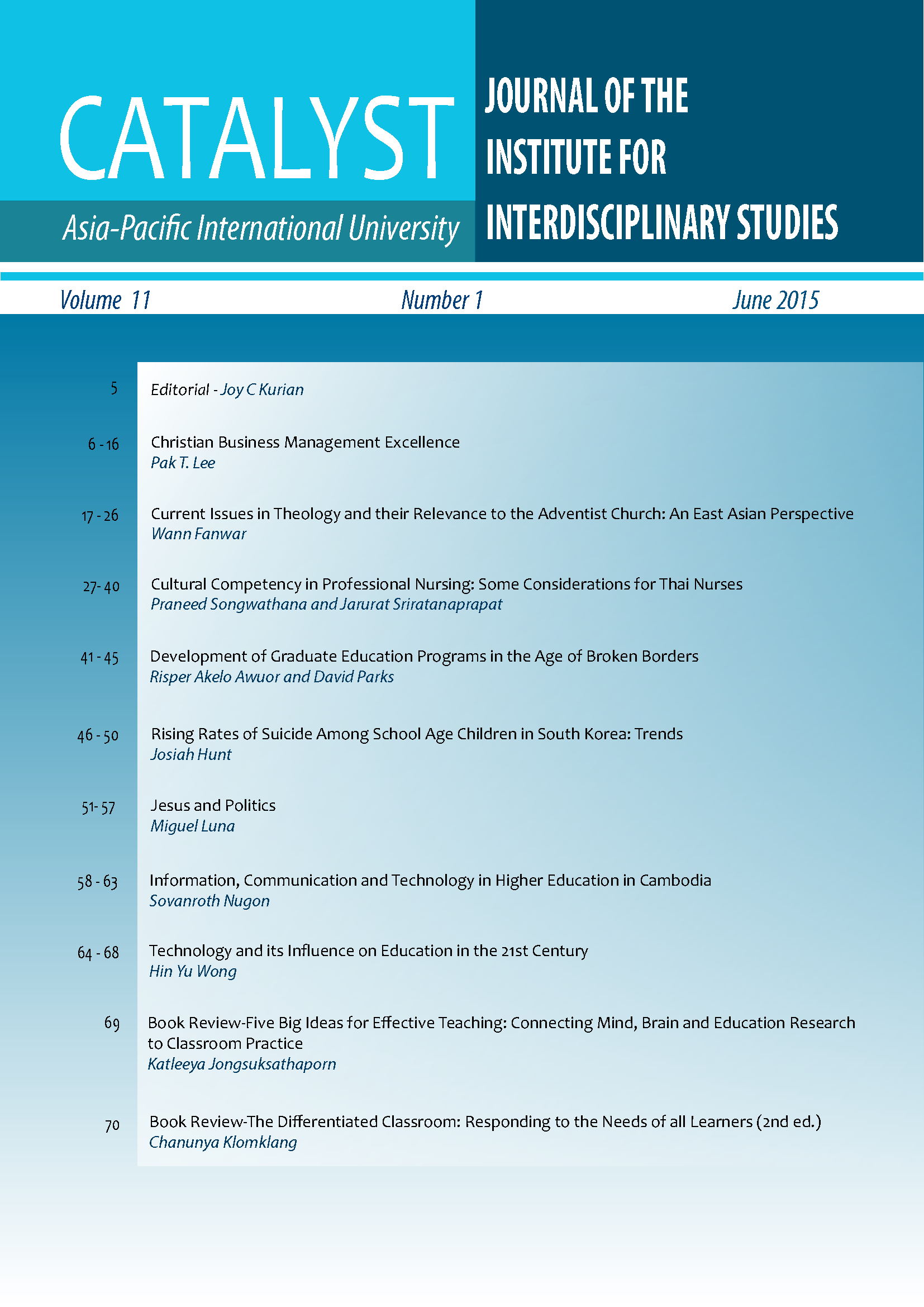Technology and its Influence on Education in the 21st Century
Main Article Content
Abstract
Improvements in technology are paving the way to provide better opportunities to increase better learning and teaching in the higher education system. Nonetheless, views on the efficiency on technology are divided over such an approach and the degree to how much technology should be allowed in teaching and learning. This article explores the advantages and disadvantages of using such technology to direct teaching and learning.
Article Details
Section
Academic Articles

This work is licensed under a Creative Commons Attribution-NonCommercial-NoDerivatives 4.0 International License.
Copyright: Asia-Pacific International University reserve exclusive rights to publish, reproduce and distribute the manuscript and all contents therein.
References
AL-Bataineh, A. & Brookes, L. (2003). Advantages and disadvantages of instructional technology in the community college classroom. Retrieved from http://tesolforum.edublogs.org/files/2012/05/al_ bataineh-qwaurr.pdf
Bajpai, S. (2012). Education technology leaving teachers behind. Retrieved from http://edtechreview.in/ news/news/trends-insights/trends/39-education-technology-leaving-teachers-behind
Bane, K. (2013). Technology sometimes more distracting than helpful in class. Retrieved from http://cojmc. webfactional.com/2013/04/23/technology-sometimes-more-distracting-than-helpful-in-class/
Blair, N. (2012). Technology integration for the new 21st century learner. Retrieved from http://www.naesp. org/principal-januaryfebruary-2012-technology/technology-integration-new-21st-century-learner
Classroom technology and teacher-student interaction. (2007). Retrieved from http://www.netop.com/ fileadmin/netop/resources/productsc/education/vision/whitepapers/Vision6_Whitepaper_ Classroom%20Management_EN_Print_NRB.pdf
Dunn, J. & Dunn, K. (2013). Technology will not replace teachers. Retrieved from http://www.huffingtonpost. com/jeff-dunn/teachers-technology_b_4130200.html
Ertmer, P. & Ottenbreit-Leftwich, A. (2009). Teacher technology change: How knowledge, beliefs, and culture intersect. Retrieved from http://www.edci.purdue.edu/ertmer/docs/aera09_ertmer_leftwich.pdf
Gulley, K. P. (2003). Pros and cons of computer technology in the classroom. Retrieved from http://nau. edu/uploadedFiles/Academic/COE/About/Projects/Pros%20and%20Cons%20of%20Computer%20 Technology%20in%20the%20Classroom.pdf
Bajpai, S. (2012). Education technology leaving teachers behind. Retrieved from http://edtechreview.in/ news/news/trends-insights/trends/39-education-technology-leaving-teachers-behind
Bane, K. (2013). Technology sometimes more distracting than helpful in class. Retrieved from http://cojmc. webfactional.com/2013/04/23/technology-sometimes-more-distracting-than-helpful-in-class/
Blair, N. (2012). Technology integration for the new 21st century learner. Retrieved from http://www.naesp. org/principal-januaryfebruary-2012-technology/technology-integration-new-21st-century-learner
Classroom technology and teacher-student interaction. (2007). Retrieved from http://www.netop.com/ fileadmin/netop/resources/productsc/education/vision/whitepapers/Vision6_Whitepaper_ Classroom%20Management_EN_Print_NRB.pdf
Dunn, J. & Dunn, K. (2013). Technology will not replace teachers. Retrieved from http://www.huffingtonpost. com/jeff-dunn/teachers-technology_b_4130200.html
Ertmer, P. & Ottenbreit-Leftwich, A. (2009). Teacher technology change: How knowledge, beliefs, and culture intersect. Retrieved from http://www.edci.purdue.edu/ertmer/docs/aera09_ertmer_leftwich.pdf
Gulley, K. P. (2003). Pros and cons of computer technology in the classroom. Retrieved from http://nau. edu/uploadedFiles/Academic/COE/About/Projects/Pros%20and%20Cons%20of%20Computer%20 Technology%20in%20the%20Classroom.pdf


